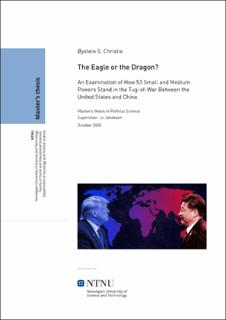| dc.contributor.advisor | Jakobsen, Jo | |
| dc.contributor.author | Christie, Øystein Soknes | |
| dc.date.accessioned | 2021-09-28T17:33:12Z | |
| dc.date.available | 2021-09-28T17:33:12Z | |
| dc.date.issued | 2020 | |
| dc.identifier | no.ntnu:inspera:65528820:37143513 | |
| dc.identifier.uri | https://hdl.handle.net/11250/2784536 | |
| dc.description.abstract | Rivaliseringen mellom Kina og USA intensiveres stadig, og de to er fanget i en tautrekkingskonkurranse over støtte fra resten av verden. I denne avhandlingen spør jeg om hvilke faktorer som påvirker hvordan små og mellomstore makter posisjonerer seg i denne kampen. Videre vil jeg finne ut hva som foregår i dagens globale arena med tanke på balansering og ‘bandwagoning’. Jeg bruker 53 staters holdninger til Asian Infrastructure Investment Bank (AIIB), Belt and Road Initiative (BRI), og Huaweis rolle i 5G som empirisk grunnlag, og utleder tre hypoteser fra veletablerte teorier innen politisk realisme. En, med grunn i Walt (1987) foreslår jeg at å oppfatte sterk trussel fra Kina gjør stater betydelig mer aksepterende eller mer avvisende til de tre initiativene og institusjonene, avhengig av trusselen og statens natur. To, med grunn i ‘patron-client’ teori (se Carney 1989) foreslår jeg at det å ha sikkerhetsbånd til USA gjør stater betydelig mer avvisende til de tre. Tre, med grunn i Hirschman (1945 [1980]) foreslår jeg at det å ha sterkere økonomiske relasjoner til Kina enn til USA gjør stater mer aksepterende til de tre – og motsatt. Ved å bruke metodene bivariat korrelasjonsanalyse, case-studier, og multivariat regresjonsanalyse finner jeg bevis for at alle de tre teoretiske dimensjonene er innflytelsesrike og nødvendige for å forstå staters holdninger til Kina. Fire av effektene jeg finner er spesielt sterke, og jeg tolker dem på følgende måte: stater som blir dverger i forhold til Kinas makt har en tendens til å ‘bandwagon’ med dem; stater som har traktatsallianser med USA har en tendens til å balansere mot Kina, og stater med frihandelsavtaler med Kina eller USA har en tendens til å henholdsvis ‘bandwagon’ med eller balansere mot Beijing. Case-studiene illustrerer at dette kun er generelle trender, og at det alltid finnes alternative tolkninger. Mot slutten diskuterer jeg noen av dagens trender og kommenterer framtiden til denne rivaliseringen.
Nøkkelord: Kina, USA, små og mellomstore makter, balansering, ‘bandwagoning’, AIIB, BRI, Huawei, 5G. | |
| dc.description.abstract | The rivalry between China and the US keeps intensifying, and they are entrenched in a tug-of-war over the world’s support. In this thesis, I pose the question of which factors influence how small and medium powers position themselves in this struggle. By extension, I also seek to establish what is happening in today’s global arena in terms of balancing and bandwagoning. Taking 53 states’ stances on the Asian Infrastructure Investment Bank (AIIB), the Belt and Road Initiative (BRI), and Huawei’s role in 5G as empirical vantage points, I derive three hypotheses from well-established branches of realism. First, deriving from Walt (1987), I suggest that perceiving a strong threat from China will make states markedly more acceptive or rejective of the three initiatives and institutions, depending on the nature of the threat and the state itself. Second, deriving from the patron-client theory of international relations (e.g. Carney 1989), I suggest that having the US as a patron makes states more rejective of the three. Third, deriving from Hirschman (1945 [1980]), I suggest that having closer economic ties with China than with the US will make states more acceptive of the three – and vice-versa. Using a mixed-methods approach of bivariate correlation-analysis, case studies, and multivariate regression analysis, I find evidence that all three theoretical dimensions are influential and necessary to understand states’ stances on China. Four of the effects I find are particularly strong, and I interpret them in the following ways: those states most dwarfed by China’s power tend to bandwagon with it; states in treaty alliances with the US tend to balance against China, and states with free trade agreements with China or with the US tend to bandwagon with it or balance against it, respectively. The case studies illustrate that these are only general trends, and that there are always alternative interpretations. Towards the end, I discuss some current trends and comment on the future of this rivalry.
Keywords: China, the United States, small and medium powers, balancing, bandwagoning, AIIB, BRI, Huawei, 5G. | |
| dc.language | | |
| dc.publisher | NTNU | |
| dc.title | The Eagle or the Dragon? An Examination of How 53 Small and Medium Powers Stand in the Tug-of-War Between the United States and China | |
| dc.type | Master thesis | |
